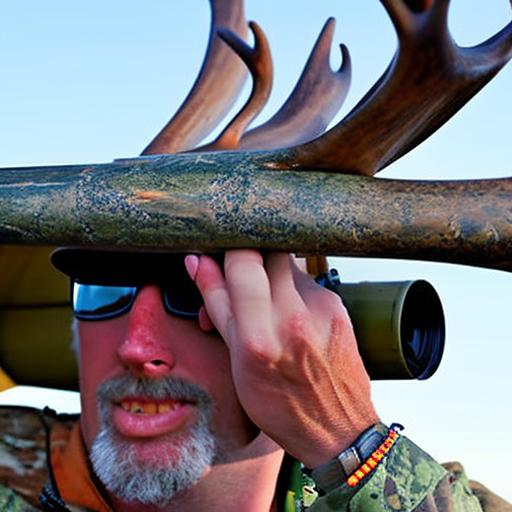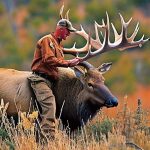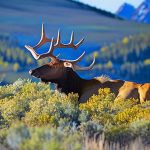Your cart is currently empty!

Mastering the Art of Elk Bow Hunting: Tips and Techniques for a Successful Hunt

Elk hunting has a long and storied history in North America. Native American tribes relied on elk as a source of food, clothing, and other materials for centuries. In more recent times, elk hunting has become a popular sport and a way for hunters to connect with nature and challenge themselves. One of the most exciting and challenging ways to hunt elk is with a bow and arrow. Elk bow hunting requires skill, patience, and knowledge of elk behavior.
Elk bow hunting has gained popularity for several reasons. First, it offers a unique and thrilling experience for hunters. The close-range encounter with such a majestic animal is an adrenaline rush like no other. Second, bow hunting allows for a more intimate connection with nature. The quietness and stealth required in bow hunting allow hunters to observe wildlife up close and personal. Finally, bow hunting is seen as a more challenging form of hunting compared to using firearms. It requires greater skill and precision to get within range of an elk and make an accurate shot.
To be successful in elk bow hunting, it is essential to have a basic understanding of elk behavior. Elk are large, powerful animals that inhabit a variety of habitats across North America. They are social animals that live in herds, typically led by a dominant male known as a bull. During the fall rutting season, bulls will bugle to attract cows and establish dominance over other males. Understanding these behaviors can help hunters locate elk and plan their approach.
Key Takeaways
- Elk bow hunting requires understanding the basics of the sport.
- Choosing the right equipment is essential for a successful elk bow hunting experience.
- Scouting for elk is crucial to finding the best hunting spots.
- Successful elk bow hunting techniques require tips and practice.
- Understanding elk behavior is key to developing strategies for a successful hunt.
Essential Gear for Elk Bow Hunting: Choosing the Right Equipment
Choosing the right gear is crucial for a successful elk bow hunt. The most important piece of equipment is the bow itself. When selecting a bow for elk hunting, it is important to choose one with enough draw weight to penetrate the thick hide and muscle of an elk. A draw weight of at least 50 pounds is recommended for elk hunting. Additionally, it is important to choose a bow that is comfortable to shoot and fits your body size and shape.
In addition to the bow, there are several accessories that are essential for elk bow hunting. A good set of arrows is crucial, as well as broadheads designed for big game hunting. It is also important to have a reliable release aid to ensure a clean and accurate shot. Other accessories such as a bow sight, stabilizer, and arrow rest can also improve accuracy and consistency.
When it comes to clothing and footwear, it is important to dress in layers and choose clothing that is quiet and scent-free. Elk have a keen sense of smell and can detect human scent from a long distance. Opting for camouflage clothing that blends in with the natural surroundings can also help hunters stay hidden from elk.
Scouting for Elk: Finding the Best Hunting Spots
Scouting is an essential part of elk bow hunting. Understanding elk habitat and behavior can help hunters identify the best areas to find elk. Elk are typically found in mountainous regions with dense forests and open meadows. They prefer areas with ample food sources such as grasses, shrubs, and trees.
One of the most effective ways to scout for elk is by using maps and other resources. Topographic maps can help hunters identify potential elk habitat based on elevation, terrain features, and water sources. Online resources such as satellite imagery and hunting forums can also provide valuable information about elk sightings and behavior in specific areas.
When scouting for elk, it is important to be patient and observant. Look for signs of elk activity such as tracks, droppings, rubs on trees, and wallows. These signs can indicate where elk have been feeding or bedding down. Pay attention to the direction of the wind and try to approach potential hunting spots from downwind to avoid alerting elk to your presence.
Elk Bow Hunting Techniques: Tips for a Successful Shot
| Technique | Description | Success Rate |
|---|---|---|
| Spot and Stalk | Hunter spots elk from a distance and stalks closer for a shot | 60% |
| Calling | Hunter uses elk calls to lure elk closer for a shot | 70% |
| Tree Stand | Hunter sets up a tree stand in an area where elk are known to frequent | 50% |
| Still Hunting | Hunter moves slowly and quietly through the woods, looking for elk | 40% |
Proper stance and form are crucial for making an accurate shot with a bow. When preparing to shoot, stand with your feet shoulder-width apart and perpendicular to the target. Keep your bow arm extended and your grip relaxed. Draw the bowstring back to your anchor point, which is the same spot on your face or jaw every time you shoot. Maintain a steady aim and release the string smoothly, without jerking or flinching.
Shot placement is also important when hunting elk with a bow. The vital organs of an elk are located in the chest cavity, just behind the front shoulder. Aiming for this area will increase the chances of a quick and ethical kill. It is important to practice shooting at different distances and angles to become familiar with the trajectory of your arrows and improve accuracy.
In different hunting situations, such as shooting from a tree stand or shooting uphill or downhill, there are additional considerations to keep in mind. When shooting from a tree stand, it is important to practice shooting from an elevated position and adjust your aim accordingly. When shooting uphill or downhill, it is important to compensate for the angle by aiming slightly higher or lower than you would on level ground.
Understanding Elk Behavior: Strategies for a Successful Hunt
Understanding elk behavior can greatly increase the chances of a successful hunt. Elk are social animals that communicate through vocalizations and body language. During the rutting season, bulls will bugle to attract cows and establish dominance over other males. By learning to recognize these vocalizations, hunters can locate elk and plan their approach.
Using calls and decoys can also be effective strategies for elk bow hunting. Elk calls mimic the sounds of elk bugling or cow calls, which can attract curious elk within range. Decoys can be used to create a visual attraction and draw elk closer for a shot. It is important to practice using calls and decoys before the hunt to ensure proper technique and realistic sounds.
Stalking and approaching elk requires patience, stealth, and knowledge of their behavior. Elk have excellent senses of hearing, smell, and sight, so it is important to move slowly and quietly. Pay attention to the wind direction to avoid alerting elk to your presence. Use natural cover such as trees, rocks, and terrain features to stay hidden and get within range for a shot.
Elk Bow Hunting Safety: Staying Safe in the Wilderness

Safety should always be a top priority when hunting, especially in the wilderness. Before heading out on an elk bow hunt, it is important to familiarize yourself with basic wilderness safety tips. This includes carrying essential survival gear such as a map, compass, first aid kit, and emergency shelter. It is also important to let someone know your hunting plans and expected return time.
Hunting-specific safety considerations should also be taken into account. Always treat your bow as if it is loaded and never point it at anything you do not intend to shoot. Be aware of your surroundings and other hunters in the area. It is also important to practice proper firearm safety if you are carrying a backup firearm for protection.
Preparing for emergencies is another important aspect of elk bow hunting safety. This includes knowing how to navigate in the wilderness, starting a fire for warmth or signaling for help, and administering basic first aid. It is also important to carry a means of communication such as a cell phone or satellite messenger in case of an emergency.
Tracking and Retrieving Elk: Techniques for a Successful Hunt
After making a successful shot on an elk, it is important to be able to track and retrieve the animal. This starts with blood trailing and tracking. Look for blood droplets or tracks that indicate the direction the elk went after being shot. Follow the blood trail carefully, marking it with flagging tape or other markers as you go.
Once you have located the downed elk, it is important to field dress and process the animal as quickly as possible. Field dressing involves removing the internal organs to cool the meat and prevent spoilage. It is important to have a sharp knife and knowledge of anatomy to perform this task properly. After field dressing, the elk can be quartered and packed out of the field.
Packing out meat can be a physically demanding task, especially if you are hunting in remote or rugged terrain. It is important to have a sturdy backpack or game cart to transport the meat. Take breaks as needed and stay hydrated to avoid exhaustion or injury. It is also important to properly care for the meat once you have returned home, including butchering and freezing it in a timely manner.
Elk Bow Hunting Ethics: Respecting the Wildlife and the Environment
Hunting regulations and ethics play an important role in elk bow hunting. It is important to familiarize yourself with local hunting regulations and obtain any necessary licenses or permits before heading out on a hunt. Follow all hunting laws and regulations, including bag limits, shooting hours, and weapon restrictions.
Respecting the wildlife and the environment is also an important aspect of elk bow hunting ethics. This includes practicing Leave No Trace principles, such as packing out all trash and minimizing your impact on the natural surroundings. It also means treating the animal with respect and gratitude for providing sustenance.
Preparing for the Hunt: Physical and Mental Training
Preparing for an elk bow hunt requires physical fitness and conditioning. Elk hunting often involves hiking long distances in rugged terrain, sometimes at high elevations. It is important to build up your endurance and strength through regular exercise such as hiking, running, weightlifting, or other cardiovascular activities.
Mental preparation is also important for a successful hunt. Visualize yourself making a clean shot and successfully tracking and retrieving an elk. Practice shooting your bow regularly to build confidence and consistency. Familiarize yourself with the terrain and potential hunting spots through maps and online resources.
Elk Bow Hunting Tips and Tricks: Expert Advice for a Successful Hunt
Experienced hunters have a wealth of knowledge and tips to share with those new to elk bow hunting. Some common tips include:
– Be patient and persistent. Elk hunting can be challenging, but perseverance pays off.
– Hunt during the rutting season when elk are more active and vocal.
– Learn to read elk sign and understand their behavior patterns.
– Practice shooting from different positions and angles to prepare for different hunting situations.
– Stay scent-free by using scent-blocking clothing and scent-control products.
– Hunt with a partner for safety and to increase your chances of success.
In conclusion, elk bow hunting is a thrilling and challenging pursuit that requires skill, knowledge, and preparation. By understanding elk behavior, choosing the right gear, scouting effectively, using proper techniques, respecting safety guidelines, tracking and retrieving elk, adhering to ethical standards, and preparing physically and mentally, hunters can increase their chances of a successful hunt. With practice and experience, elk bow hunting can become a rewarding and fulfilling outdoor activity.
If you’re an avid elk bow hunter, you might also be interested in learning about the best time of year to hunt rabbits. Hunting rabbits can be a thrilling and challenging experience, and knowing when they are most active can greatly increase your chances of success. Check out this informative article on the Old Oak Syndicate website: Best Time of Year to Hunt Rabbits. Happy hunting!
FAQs
What is elk bow hunting?
Elk bow hunting is a type of hunting where a bow and arrow is used to hunt elk.
What is the best time of year for elk bow hunting?
The best time of year for elk bow hunting is during the rut, which typically occurs in September and October.
What equipment do I need for elk bow hunting?
You will need a bow, arrows, broadheads, a hunting license, and appropriate clothing and gear for the weather and terrain.
What is the success rate for elk bow hunting?
The success rate for elk bow hunting varies depending on the skill level of the hunter and the conditions of the hunt. On average, the success rate is around 10-20%.
What are some tips for elk bow hunting?
Some tips for elk bow hunting include scouting the area beforehand, practicing shooting from different angles and distances, using scent control, and being patient and persistent.
Is elk bow hunting legal?
Elk bow hunting is legal in many states, but regulations and requirements vary. It is important to check with your state’s wildlife agency for specific rules and regulations.

Herb has been a longtime lover of the outdoors. Whether it be hunting, camping, fishing or just getting outside to reset. Proud father and animal lover. Bourbon anyone?

by
Tags:
Comments

Categories
- Big Game Hunting (301)
- Deer (202)
- Reviews (3)
- Shooting (16)
- Slingshot (1)
- Small Game Hunting (42)
- Upland Hunting (126)
- Waterfowl Hunting (3)





Leave a Reply